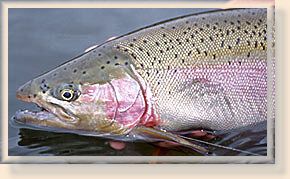The High Desert Lakes of British Columbia
Part Two

By Gordon Honey
The Season
Historical averages indicate May 1 as typical ice off and beginning of the season.
But dependent on the severity of the winter and the elevation, many valley lakes
are free of ice as early as late March and early April. A word of caution however;
check the Fresh Water Angling Regulations's carefully before venturing out, as
many lakes are closed and do not open for angling until May 1. It is usually only
the very keen and the very hardy who venture out in March and early April.
Although many days can be bright and warm, dress in layers and be prepared
for sudden squals bringing chilly winds. Wind, our friend when it assists in the vital
oxygenation of the lakes, or when it provides us with gentle cover of a fly fisher's
riffle when casting in shallower water, but oh how we curse it, when the anchors
no longer hold and we are blown off the lake! The season moves into full swing as
May begins, the only negative you may experience at this time might be, arriving
at the chosen water, find it slightly off clarity or murky, the lake has turned over or
mixed as all lakes must do in the spring and fall to remain properly oxygenated.
When a lake has turned over the poor water quality impacts on the angling as well,
this condition typically lasts for two weeks. As the days warm and become longer
the insect hatches increase as the water warms, stillwater fly fishing has begun in
earnest.
In June, and as July approaches the warm weather of the Central Interior begins
in earnest, valley temperatures in the Kamloops area, can reach upwards of 100
degrees F. The fly fisher must now move to higher elevations, as the trout in the
valley lakes seek the cooler waters of the thermocline, feeding in the shallower
waters of the shoals, only as the evening approach. These conditions remain until
the latter part of August when evening air temperatures begin to cool, as do the
water temperatures. September brings the first frosts that touch the leaves of not
only the deciduous forest trees, but also the exposed tips of the lakes aquatic
vegetation. As the frosts increase through September and October, the larger
fish return to the shoals and shallower water, where they can, at times, forage
voraciously, sensing the return of winter and it's cover of ice and snow.
Tackle, Key Time Periods and Food Sources
Fly fishing stillwaters is perhaps a new experience for you and will require some
adjustments not only in your traditional techniques, but also in the gear you use.
Of the lakes in the Central Interior of B.C. 99.9% are not conducive to wading.
Fly fishing requires the use of either a float tube or a boat. Many of the better lakes
are quite large, making the use of a float tube limited or dangerous, tubes are ideal
for the numerous smaller lakes. The vast majority of area angling is from boats; they
are available for rent from fish camps or resorts.
Angling from a boat could very well be foreign to you, here are some thoughts:
Your boat should carry at least one anchor, (preferable two), you have much better
control of your fly line, and therefore your ability to impart the correct action of your
chosen fly pattern.
Use a gasoline motor only on large lakes, using the oars to row quietly as you approach
the shoal or drop-off you are going to fish.
Loose carpeting covering the interior bottom of the boat will protect your valuable fly
line, keeping it clean from sand and grit, and will also help muffle boat noise's especially
in an aluminum hull.
Keep the area at your feet uncluttered, it is very frustrating when the line tangles in your
fly bag or whatever else it can find. You would not be a happy angler, when you finally
hook Walter and as he rips coiled line from the bottom, in the first powerful run, and
the last coil of line wraps around the clutter; -- ping, Walter, with your tippet in tow,
swims peacefully away!!
Wear soft soled shoes so, that if you do step on your fly line, it will happen, no
damage will occur. Soft soles also help in muffling sounds as you move about.
Boat and Float Tube Etiquette
As you approach the key area and find that other have preceded you, row or
paddle slowly and quietly, maintain a distance of at lest 150 to 200 ft., from
those already anchored. This should be especially noted when in a tube, as
your depth perception is distorted by your proximity to the surface. As you
move into position, never, ever come between another angler and the shoreline.
Release your anchors quietly, an anchor thrown or splashed loudly will scatter
fish and draw the ire of those around you.
More next time. ~ Gordon Honey
Credits: From Angling in the Shadows of the Rockies
by Jeff Mironuck We thank
Frank Amato Publications, Inc. for use permission!
Our Man In Canada Archives
|

